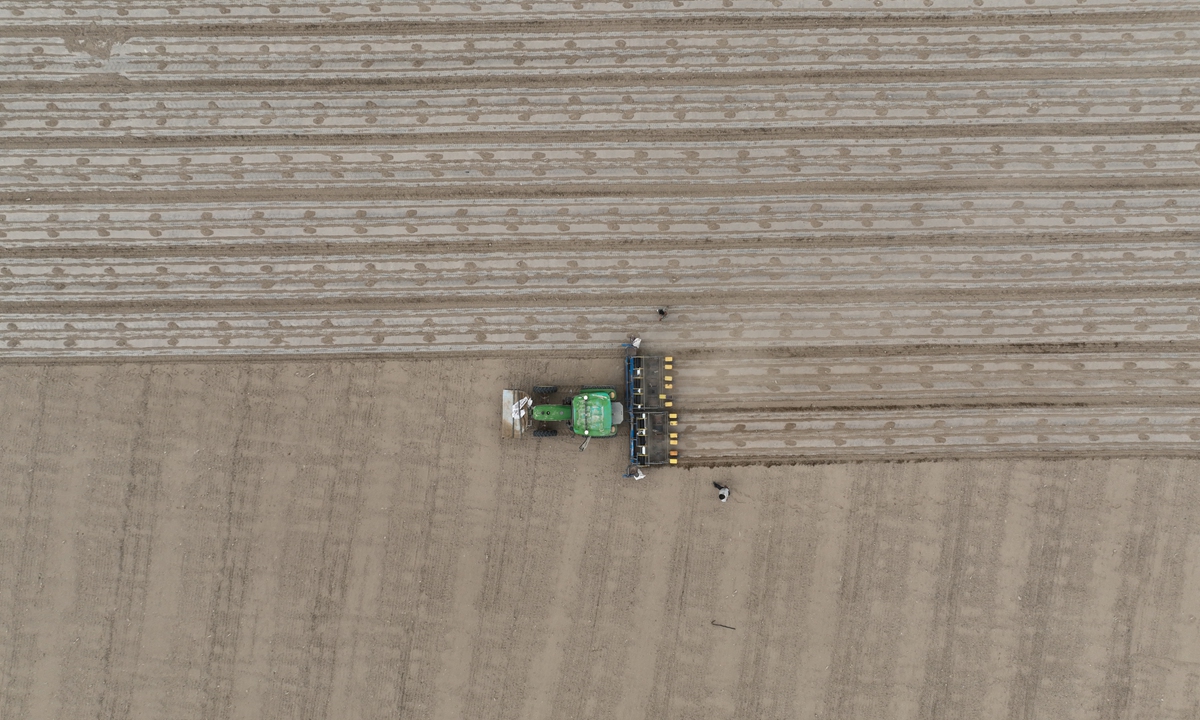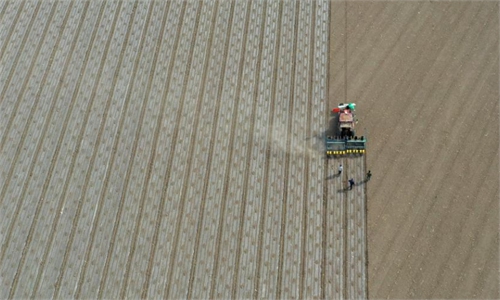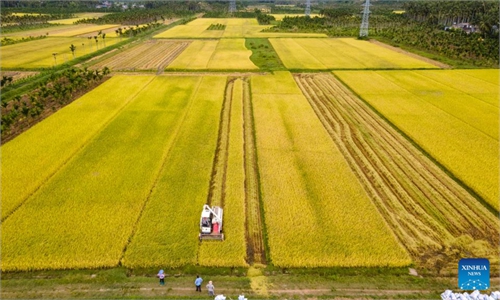Domestic grain supply guaranteed by upgraded tech, favorable conditions despite challenges

Farmers sow cotton seeds with a seeder equipped with the BeiDou Navigation Satellite System in Bohu county, Northwest China's Xinjiang Uygur Autonomous Region on April 8, 2022. Photo: VCG
On a vast field in Northwest China's Xinjiang Uygur Autonomous Region, a major cotton-growing region in China, unmanned tractors, guided by the Chinese-developed BeiDou Navigation Satellite System, have been used in the busy spring farming of cotton from ditching, planting to laying film and covering soil, fulfilling an almost fully mechanized operation.
Data from Xinjiang's agriculture authority showed that as of May 14, the area of spring planting in the region exceeded 48 million mu. The planting task for spring wheat has been successfully completed, and the planting area for cotton exceeded 23 million mu, 2.4 million mu more than the same period last year.
The total mechanization level of Xinjiang's agriculture has been continuously increased, leading to the improvement of production efficiency, crop quality and farmers' incomes. Although this year's spring ploughing has been affected by the increasing prices of pesticides and fertilizers, it is believed that the Xinjiang region's momentum of strong harvests will persist this year, local farmers told the Global Times.
"My family has 20 mu (1.33 hectares) of walnut fields. In the past years, at least two or three people were needed to fertilize the land. Now it is different. The fertilizer spreader equipped with BeiDou system can complete all the fertilization work in half a day," a farmer in Wensu county of Xinjiang's Aksu Prefecture told the Global Times.
This year, she not only used drones for pollination and pest prevention in her orchard, but also achieved mechanized fertilization.
In another village in Baicheng county, Aksu Prefecture, with the sound of rotors on, three drones, controlled by a human pilot, were spraying pesticide to protect the wheat crop from pests and diseases. In just half an hour, the pesticide spraying area had covered more than 100 mu.
"In the past, spraying pesticide was carried out by farmers with a sprayer on the back, which was time-consuming and labor-intensive. Now the use of drones not only result in good control effect, but also saves planting costs," a local villager told the Global Times, adding that there will be a good harvest of wheat this year thanks to the application of high technologies.
The Global Times found that as crops such as cotton, wheat, corn, vegetables and fruits across the Xinjiang region have entered the field management period one after another, the majority of local villagers have started using smart agricultural machinery such as drones, tractors and fertilizer spreaders equipped with the BeiDou Navigation Satellite System, signaling a good start for stable production and increase of agricultural incomes this year.
According to the monitoring conducted by China's Ministry of Agriculture and Rural Affairs (MARA), modern agricultural machinery is widely used in cotton farming in Xinjiang. In 2022, the comprehensive mechanization level for cropping in Xinjiang reached 85.7 percent, according to local media reports.
The spring farming work in Xinjiang is now drawing to an end. Thanks to good weather conditions and sufficient preparation work, the overall progress of spring farming across the region this year has been faster than the same period last year.
Apart from the high technologies widely adopted in Xinjiang, the nation's favorable conditions including support policies have also contributed to ensure a stably grain production and recovery in regions hit by the domestic COVID-19 outbreaks, including Northeast China's Jilin Province.
Tackling challenges
Affected by the Russia-Ukraine conflict, which has pushed up global prices for food, coupled with COVID-19 resurgence in multiple localities across China, the country's spring farming progress has gained much more attention since March as it is key to the overall stable grain production of China.
The international agriculture market has seen increasing fluctuations this year. Given the Ukraine crisis may persist for a period of time and natural disasters remain a risk, global agriculture commodity prices will stay high, Jiao Shanwei, editor-in-chief of industry news website cngrain.com, told the Global Times.
In a bid to ease the supply tensions, local governments at different levels in China have stepped up efforts to ensure the supply of agricultural materials, and the availability of chemical fertilizers has steadily increased, meeting the needs of spring ploughing, a MARA official told a press conference at the end of April.
During the spring ploughing period this year, the total demand for chemical fertilizers has been estimated at about 39.8 million tons, and the total supply reached 48.3 million tons including domestic supply, inventory and imports, meaning the total supply of chemical fertilizers is guaranteed, the official said.
Apart from rising raw material prices, difficulties brought about by the resurgence of COVID-19 in several provinces have also weighed on China's spring farming progress during its early stages.However, the pace was then quickly caught up thanks to the all-out efforts to guarantee the smooth logistics of agricultural materials and personnel deployment.
Jilin Province, the country's second-biggest corn-growing province which was hit very hard by the COVID-19 flare-ups from March, has completed 80.55 percent of its grain sowing area as of May 13, faster than the same period last year, local agriculture data showed, thanks to supportive measures implemented by the government from the beginning of April.
The province plans to complete 86 million mu of grain planting in 2022, with output stabilizing at over 80 billion jin (40 billion kilograms) under normal conditions, and the soybean planting area being expanded by more than 800,000 mu in key areas.
In Nanning, capital of South China's Guangxi Zhuang Autonomous Region, spring ploughing production has been progressing smoothly. As of May 5, a total of 1.9 million mu of early rice had been planted, reaching 100.99 percent of the city's early rice planting quota, according to data from local agricultural authorities.
China has been ramping up efforts to ensure grain production and supply over recent years. Though challenges remain, overall domestic supply is not a problem, Jiao noted.
The application of new technological innovations including the BeiDou Navigation Satellite System, 5G network, robots and other cutting-edge technologies leveraging farming machinery system, favorable procurement prices and supportive government policies have all helped to maintain sufficient grain supply for the Chinese people and there is no need to be overly concerned about "food crisis," which is actually nonexistent in China, Jiao noted.
In response to the rising prices of production materials, the central government has allocated 20 billion yuan ($3.14 billion) to issue one-time subsidies to the farmers growing grain across the country.
The production of the summer grain keeps improving while spring sowing activities are also progressing smoothly, Fu Linghui, a spokesperson from the National Statistics of Bureau, said at a press briefing on Monday. Fu noted that the country has been implementing support polices and measures for grain production such as increasing the minimum purchasing prices for rice and wheat.
Meanwhile, Fu stressed that the average returns on grain cultivation per mu reached to its highest in nearly 5 years in 2021 to 824 yuan per mu, as high levels of food prices since last year serve as a motivation for farmers to expand planting areas.
China's grain output reached a record high of 682.85 million tons in 2021, according to the country's statistics bureau, exceeding 650 million tons for the seventh consecutive year, the government's "No.1 central document" revealed.



